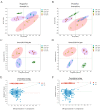Identification of Metabolites in Muscles of Lueyang Black-Bone Chickens: A Comparative Analysis of Caged and Cage-Free Rearing Modes Using Untargeted Metabolomic Techniques
- PMID: 39061503
- PMCID: PMC11274139
- DOI: 10.3390/ani14142041
Identification of Metabolites in Muscles of Lueyang Black-Bone Chickens: A Comparative Analysis of Caged and Cage-Free Rearing Modes Using Untargeted Metabolomic Techniques
Abstract
The Lueyang black-bone chicken is a specific native chicken strain in China. This study aimed to investigate the effects of different rearing systems on the meat quality of Lueyang black-bone chickens. Six hundred Lueyang black-bone hens were randomly divided into two groups at 7 weeks of age and raised in cage and cage-free systems for 20 weeks. The carcass yield, meat quality, and total metabolites were measured in both the leg and breast muscles. By comparison, the carcass yield of hens in the cage-free (CF) group (1.26 ± 0.09 kg) was significantly lower than that in the caged rearing (CR) group (1.52 ± 0.15 kg). However, the shear force of leg muscles in the CF group (27.98 ± 2.43 N) was significantly greater than that in the CR group (24.15 ± 1.93 N). In addition, six samples from each group were randomly selected and their metabolites were detected by the non-targeted metabolomics technique. Among these metabolites, 408 and 354 significantly differentially abundant metabolites were identified in breast and leg muscles, which were mainly involved in glycerophospholipid metabolism, unsaturated fatty acid biosynthesis, arginine and proline metabolism, and nucleotide metabolism. We found that the levels of 19 phospholipids, mainly phosphatidylcholines and lysophosphatidylcholines, were significantly greater in the CF group than in the CR group. Additionally, the contents of eight unsaturated fatty acids, linoleic acid, and linolenic acid were dramatically greater in the CF group than in the caged group. The accumulation of 4-hydroxy-proline, glutamate, and adenosine 3'-monophosphate (AMP) was enhanced in the CF group. Moreover, many more volatile organic compounds were identified in the muscles of the cage-free group, enhancing the flavor of the chicken meat. In conclusion, the cage-free rearing mode facilitates the accumulation of nutrients and flavor substances in the chicken meat and is a better rearing system for Lueyang black-bone chickens.
Keywords: black-bone chicken; meat quality; metabolomics; rearing system.
Conflict of interest statement
Guoqiang Yuan is from the Shaanxi Baiweiyuan Network Technology Company but there is no conflict of interest.
Figures







Similar articles
-
Influence of slaughter age on meat quality, metabolite and volatile organic compound changes in Lueyang black-bone chickens.Poult Sci. 2025 Jun 3;104(9):105390. doi: 10.1016/j.psj.2025.105390. Online ahead of print. Poult Sci. 2025. PMID: 40483908 Free PMC article.
-
Effects of Different Rearing Systems on Lueyang Black-Bone Chickens: Meat Quality, Amino Acid Composition, and Breast Muscle Transcriptome.Genes (Basel). 2022 Oct 19;13(10):1898. doi: 10.3390/genes13101898. Genes (Basel). 2022. PMID: 36292783 Free PMC article.
-
Transcriptomic and Metabolomic Profile Analysis of Muscles Reveals Pathways and Biomarkers Involved in Flavor Differences between Caged and Cage-Free Chickens.Foods. 2022 Sep 17;11(18):2890. doi: 10.3390/foods11182890. Foods. 2022. PMID: 36141015 Free PMC article.
-
Integrative metabolomics and transcriptomics analysis revealed specific genes and metabolites affecting meat quality of chickens under different rearing systems.Poult Sci. 2024 Sep;103(9):103994. doi: 10.1016/j.psj.2024.103994. Epub 2024 Jun 24. Poult Sci. 2024. PMID: 38991385 Free PMC article.
-
Unraveling the flavor profiles of chicken meat: Classes, biosynthesis, influencing factors in flavor development, and sensory evaluation.Compr Rev Food Sci Food Saf. 2024 Jul;23(4):e13391. doi: 10.1111/1541-4337.13391. Compr Rev Food Sci Food Saf. 2024. PMID: 39042376 Review.
Cited by
-
Influence of slaughter age on meat quality, metabolite and volatile organic compound changes in Lueyang black-bone chickens.Poult Sci. 2025 Jun 3;104(9):105390. doi: 10.1016/j.psj.2025.105390. Online ahead of print. Poult Sci. 2025. PMID: 40483908 Free PMC article.
-
Comparative analysis of the quality characteristics and flavor volatiles of Lueyang black-bone chicken meatballs cooked via different methods.Front Nutr. 2025 Jul 23;12:1629738. doi: 10.3389/fnut.2025.1629738. eCollection 2025. Front Nutr. 2025. PMID: 40771214 Free PMC article.
-
Multi-Omics Profiling of Lipid Variation and Regulatory Mechanisms in Poultry Breast Muscles.Animals (Basel). 2025 Feb 27;15(5):694. doi: 10.3390/ani15050694. Animals (Basel). 2025. PMID: 40075981 Free PMC article.
-
Effects of Different Rearing Methods on the Intestinal Morphology, Intestinal Metabolites, and Gut Microbiota of Lueyang Black-Bone Chickens.Animals (Basel). 2025 Jun 14;15(12):1758. doi: 10.3390/ani15121758. Animals (Basel). 2025. PMID: 40564310 Free PMC article.
-
Free-caged rearing modes regulate chicken intestinal metabolism by influencing gut microbial homeostasis.Poult Sci. 2025 Jan;104(1):104381. doi: 10.1016/j.psj.2024.104381. Epub 2024 Oct 28. Poult Sci. 2025. PMID: 39693966 Free PMC article.
References
-
- Zhang Z., Li G., Wei Y., Feng Z., Fang L., Li M., Ren J., Liu W., Gan J. In vitro immunomodulatory and antioxidant effects of oligopeptides and four characteristic peptides in black-bone silky fowl (Gallus gallus domesticus Brisson) J. Food Biochem. 2022;46:e14469. doi: 10.1111/jfbc.14469. - DOI - PubMed
-
- Jian H., Zu P., Rao Y., Li W., Mou T., Lin J., Zhang F. Comparative analysis of melanin deposition between Chishui silky fowl and Taihe silky fowl. J. Appl. Anim. Res. 2021;49:366–373. doi: 10.1080/09712119.2021.1981911. - DOI
Grants and funding
LinkOut - more resources
Full Text Sources

